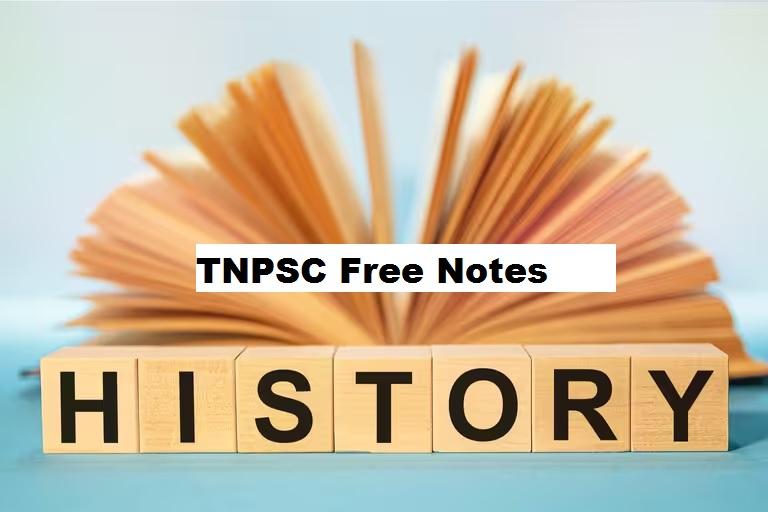இந்தக் கட்டுரையில், TNPSC குரூப் 1, குரூப் 2, குரூப் 2A, குரூப் 4 மாநிலப் போட்டித் தேர்வுகளான TNUSRB, TRB, TET, TNEB போன்றவற்றுக்கான முறைகள் இலவசக் குறிப்புகளைப் பெறுவீர்கள்.தேர்வுக்கு தயாராவோர் இங்குள்ள பாடக்குறிப்புகளை படித்து பயன்பெற வாழ்த்துகிறோம்.
Rashtrakutas
Origin
The Rashtrakutas were of Kannada origin and Kannada language was their mother
tongue.
They ruled small kingdoms in northern and central India and the Deccan between the 6 th
and 7 th centuries.
Dantidurga was the founder of the Rashtrakuta dynasty.
He defeated the Gurjaras and captured Malwa from them. Then he annexed the
Chalukya kingdom by defeating Kirtivarman II.
Rashtrakuta Kings
His successor, Krishna I was also a great conqueror. He defeated the Gangas and the
eastern Chalukyas of Vengi.
He built the magnificent rock-cut monolithic Kailasa temple at Ellora.
The next important king of this dynasty was Govinda III. He achieved victories over north
Indian kingdoms.
His successor Amoghavarsha I (815- 880 A.D.) ruled for a long period of 64 years. He was
a follower of Jainism.
He was also a patron of letters and he himself wrote the famous Kannada work,
Kavirajamarga. He had also built the Rashtrakuta capital, the city of Malkhed or
Manyakheda.
Among the successors of Amoghavarsha I, Krishna III (936- 968 A.D.) was famous for his
expeditions. He marched against the Cholas and defeated them at Takkolam. He
marched further south and captured Tanjore.
He built several temples in the conquered territories including the Krishneswara temple
at Rameswaram. Throughout his reign, he possessed the Tondaimandalam region
including the capital Kanchi.
After his death, the power of the Rashtrakutas declined.
Administration
The Rashtrakuta Empire was divided into several provinces called rashtras under the
control of rashtrapatis.
They were further divided into vishayas or districts governed by vishayapatis.
The next subdivision was bhukti consisting of 50 to 70 villages under the control of
bhogapatis.
These officers were directly appointed by the Central Government. The village
administration was carried on by the village headmen.
However, the village assemblies played a significant role in the village administration.
Society & Economy
The Hindu sects of Vaishnavism and Saivism flourished during the period of
Rashtrakutas. Yet, they did not affect the progress of Jainism under the patronage of
Rashtrakuta kings and officers.
Almost one-third of the population of the Deccan was Jains. There were some
prosperous Buddhist settlements at places like Kanheri, Sholapur and Dharwar. There
was harmony among various religions.
There was a college at Salatogi, situated in the modern Bijapur district.
An inscription gives details of this educational center. It was run by the income from the
endowments made by the rich as well as by all the villagers on occasions of functions
and festivals.
The economy was also in a flourishing condition. There was an active commerce
between the Deccan and the Arabs. The Rashtrakuta kings promoted the Arab trade by
maintaining friendship with them.
Cultural Contributions
The Rashtrakutas widely patronised Sanskrit literature. There were many scholars in the
Rashtrakuta court.
Trivikrama wrote Nalachampu, and the Kavirahasya was composed by Halayudha during
the reign of Krishna III.
The Jain literature flourished under the patronage of the Rashtrakutas.
Amogavarsha I, who was a Jain, patronized many Jain scholars. His teacher Jinasena
composed Parsvabhudaya, a biography of Parsva in verses.
Another scholar, Gunabhadra, wrote the Adipurana, the life stories of various Jain
saints. Sakatayana wrote the grammar work called Amogavritti.
The great mathematician of this period, Viracharya, was the author of Ganitasaram.
The Kannada literature saw its beginning during the period of the Rashtrakutas.
Amogavarsha’s Kavirajamarga was the first poetic work in the Kannada language.
Pampa was the greatest of the Kannada poets. His famous work was Vikramasenavijaya.
Ponna was another famous Kannada poet and he wrote Santipurana.
Art & Architecture
The art and architecture of the Rashtrakutas were found at Ellora and Elephanta.
At Ellora, the most remarkable temple is the Kailasa temple. It was excavated during the
reign of Krishna I.
It is carved out of a massive block of rock 200 feet long, and 100 feet in breadth and
height.
The temple consists of four parts – the main shrine, the entrance gateway, an
intermediate shrine for Nandi and mandapa surrounding the courtyard.
The central face of the plinth has imposing figures of elephants and lions giving the
impression that the entire structure rests on their back.
It has a three-tiered sikhara or tower resembling the sikhara of the Mamallapuram
rathas. In the interior of the temple, there is a pillared hall that has sixteen square
pillars.
The Kailasa temple is an architectural marvel with its beautiful sculptures. The sculpture
of the Goddess Durga is shown as slaying the Buffalo demon.
In another sculpture, Ravana was making attempts to lift Mount Kailasa, the abode of
Siva. The scenes of Ramayana were also depicted on the walls.
The general characteristics of the Kailasa temple are more Dravidian.
Elephanta is an island near Bombay. It was originally called Sripuri. The Portuguese after
seeing the large figure of an elephant named it Elephanta.
At the entrance to the sanctum, there are huge figures of dwara-palakas.
The most imposing figure of this temple is Trimurthi. The sculpture is six-meter high. It is
said to represent the three aspects of Shiva as Creator, Preserver and Destroyer.
**************************************************************************
| Adda247 TamilNadu Home page | Click here |
| Official Website=Adda247 | Click here |









